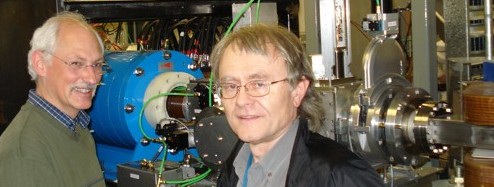
On November 11, 2008, a team of scientists led by Dr. Friedhelm Ames successfully accelerated a beam of 80Rb14+ ions at TRIUMF’s ISAC facility. This represents the first accelerated, charge-bred rare isotope beam (RIB) at ISAC, making ISAC one of only three facilities in the world with this capability and signaling the beginning of a new program of nuclear physics at TRIUMF.
Until now, the heaviest RIB accelerated at ISAC had been 29Na. The radio frequency quadrupole (RFQ), the first device in the ISAC accelerator chain, is capable of accelerating ions with a mass-to-charge ratio (A/q) of less than thirty. As the rare isotopes produced at ISAC are generally singly charged (q=1), this has placed an effective limit of 30 on the atomic mass (A) of the ions that can be accelerated. For heavier ions, higher charge states are required.
The newly installed Charge State Booster (CSB) has been designed to achieve those higher charge states. The heart of the CSB is an electron cyclotron resonance ion source. This device uses radio-frequency energy and a containing magnetic field to generate a plasma. Ions in low charge states are injected into the plasma where additional electrons are removed, producing more highly charged ions in a process commonly referred to as “charge breeding”. These charge-bred ions are then extracted in one of several higher charge states and transported to the RFQ (and beyond). In the case of 80Rb, beam was extracted in the 14+ charge state, the state in which 14 of the rubidium atom’s full complement of 37 electrons are removed. Beam was then accelerated to an energy of 150 keV/nucleon in the RFQ. A germanium gamma-ray detector located downstream of the drift-tube linac, the second accelerator in the ISAC chain, was used to detect the characteristic gamma rays associated with 80Rb decay, confirming the successful acceleration of the isotope.
This milestone marks the culmination of five years of development by ion source physicists and technical teams.
There is significant experimental interest in accelerated rare isotope beams with atomic masses greater than 30. Having the CSB available will greatly extend ISAC’s capabilities, strengthening its position as one of the world’s premier RIB facilities. The full commissioning of the CSB will continue in the coming months, with the delivery of charge-bred RIB to experiments expected to commence in spring, 2009.
Pictured : Friedhelm Ames (left) and Josef Holek (right)
Article By: Colin Morton
Kaitlan Huckabone
TRIUMF's Communications Assistant
